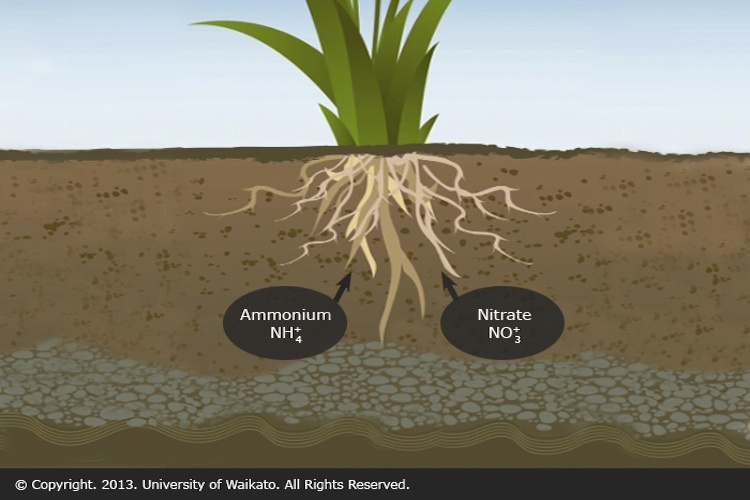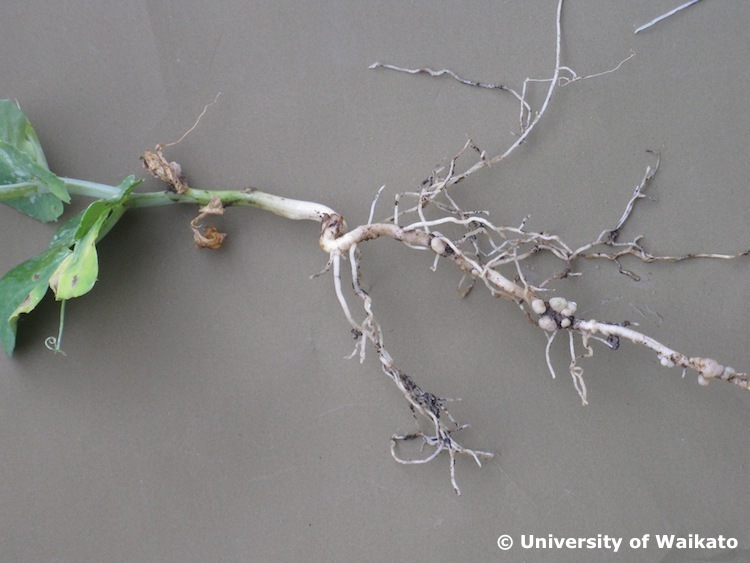Nitrogen is the most abundant element in our planet’s atmosphere. Approximately 78% of the atmosphere is made up of nitrogen gas (N2).
Nitrogen is a crucially important component for all life. It is an important part of many cells and processes such as amino acids, proteins and even our DNA. It is also needed to make chlorophyll in plants, which is used in photosynthesis to make their food.
As part of these life processes, nitrogen is transformed from one chemical form to another. The transformations that nitrogen undergoes as it moves between the atmosphere, the land and living things make up the nitrogen cycle.
Fixation
Nitrogen in its gaseous form (N2) can’t be used by most living things. (Plants for example, do not have the required enzymes to make use of atmospheric nitrogen.) It has to be converted or ‘fixed’ to a more usable form through a process called fixation. There are three ways nitrogen can be fixed to be useful for living things:
- Biologically: Nitrogen gas (N2) diffuses into the soil from the atmosphere, and species of bacteria convert this nitrogen to ammonium ions (NH4+), which can be used by plants. Legumes (such as clover and lupins) are often grown by farmers because they have nodules on their roots that contain nitrogen-fixing bacteria. Learn more about this process in the article The role of clover.
- Through lightning: Lightning converts atmospheric nitrogen into ammonia and nitrate (NO3) that enter soil with rainfall.
- Industrially: People have learned how to convert nitrogen gas to ammonia (NH3-) and nitrogen-rich fertilisers to supplement the amount of nitrogen fixed naturally.
Decomposition
Plants take up nitrogen compounds through their roots. Animals obtain these compounds when they eat the plants. When plants and animals die or when animals excrete wastes, the nitrogen compounds in the organic matter re-enter the soil where they are broken down by microorganisms, known as decomposers. This decomposition produces ammonia, which can then go through the nitrification process.
Nitrification
Nitrifying bacteria in the soil convert ammonia into nitrite (NO2-) and then into nitrate (NO3-). This process is called nitrification. Compounds such as nitrate, nitrite, ammonia and ammonium can be taken up from soils by plants and then used in the formation of plant and animal proteins.
Denitrification
Denitrification completes the nitrogen cycle by converting nitrate (NO3-) back to gaseous nitrogen (N2). Denitrifying bacteria are the agents of this process. These bacteria use nitrate instead of oxygen when obtaining energy, releasing nitrogen gas to the atmosphere.
Nitrogen compounds and potential environmental impacts
Agriculture may be responsible for about half the nitrogen fixation on Earth through fertilisers and the cultivation of nitrogen-fixing crops. Increased nitrogen inputs (into the soil) have led to lots more food being produced to feed more people – known as ‘the green revolution’.
However, nitrogen in excess of plant demand can leach from soils into waterways. The nitrogen enrichment contributes to eutrophication.
Another problem can occur during nitrification and denitrification. When the chemical process is not completed, nitrous oxide (N2O) can be formed. This is of concern, as N2O is a potent greenhouse gas – contributing to global warming.
A balance of nitrogen compounds in the environment supports plant life and is not a threat to animals. It is only when the cycle is not balanced that problems occur.
Some common forms of nitrogen
| Name | Form | Symbol |
|---|---|---|
| Gaseous dinitrogen (commonly known as nitrogen gas) | Unreactive Inorganic | N2 |
| Ammonia (gas) | Reactive Inorganic | NH3 |
| Ammonium ion | Reactive Inorganic | NH4+ |
| Nitric oxide | Reactive Inorganic | NO |
| Nitrous oxide | Reactive Inorganic | N2O |
| Nitrogen dioxide | Reactive Inorganic | NO2 |
| Nitrite | Reactive Inorganic | NO2- |
| Nitrate | Reactive Inorganic | NO3- |
| Urea | Reactive Inorganic | CO(NH2)2 |
| Organic forms are a very diverse group of nitrogen-containing organic molecules including simple amino acids through to large complex proteins and nucleic acids in living organisms and humic compounds in soil and water | Reactive organic forms of nitrogen | Numerous, typically R-NH2 |
Nature of science
Scientists make observations and develop their explanations using inference, imagination and creativity. Often they use models to help other scientists understand their theories. The nitrogen cycle diagram is an example of an explanatory model. Diagrams demonstrate the creativity required by scientists to use their observations to develop models and to communicate their explanations to others.
Activity idea
Students may enjoy experimenting with components of the nitrogen cycle in the student activity, Nitrification and denitrification.
Related content
Take a closer look at dairy farming and the nitrogen cycle with this article and interactive.
Useful link
See how nitrogen leaching due to agriculture has increased over time in New Zealand.



